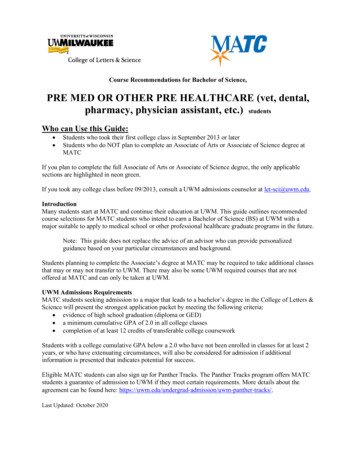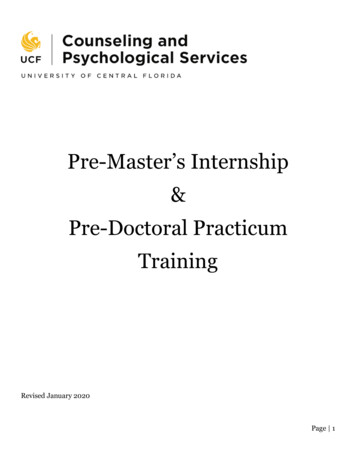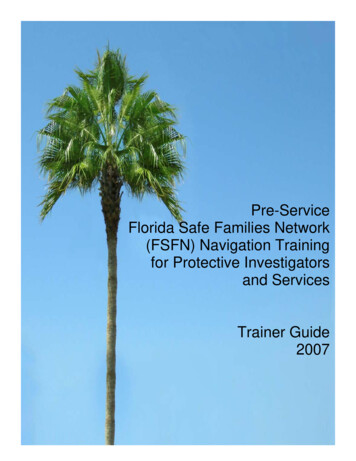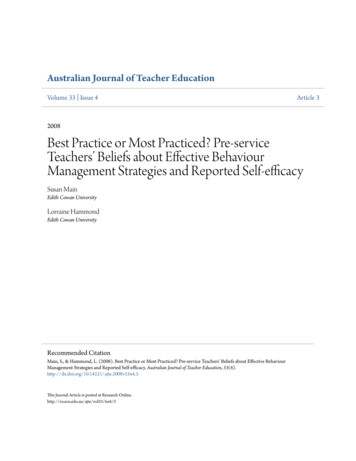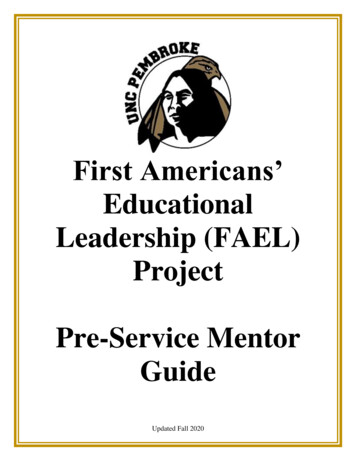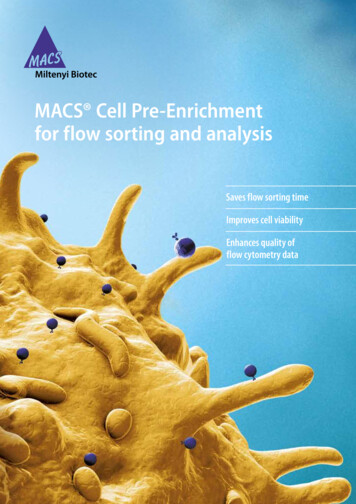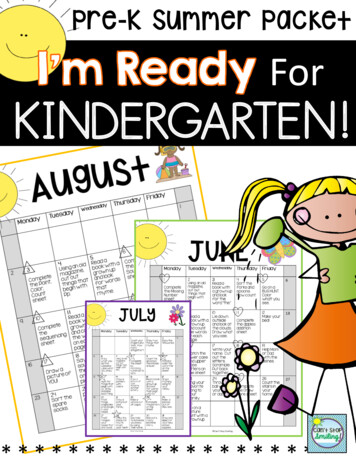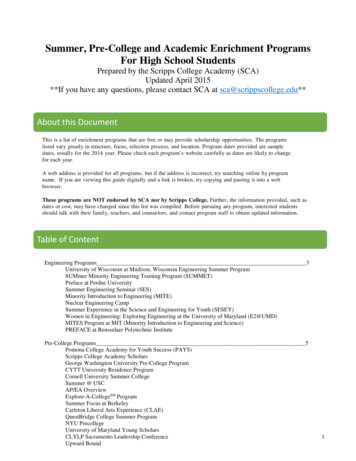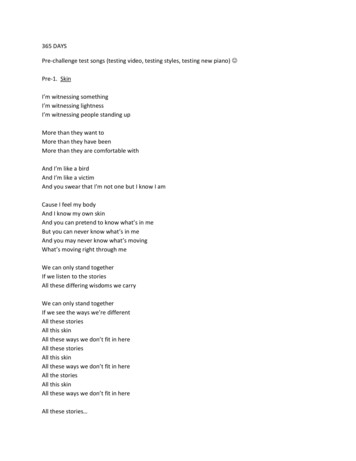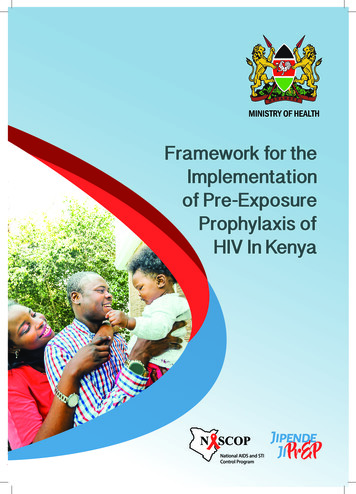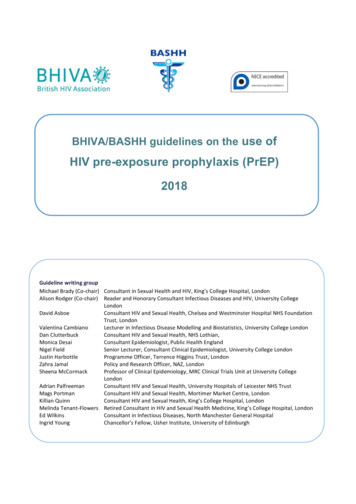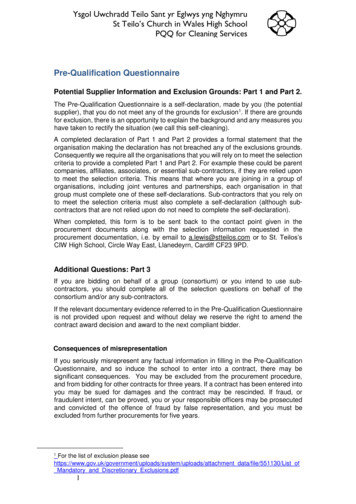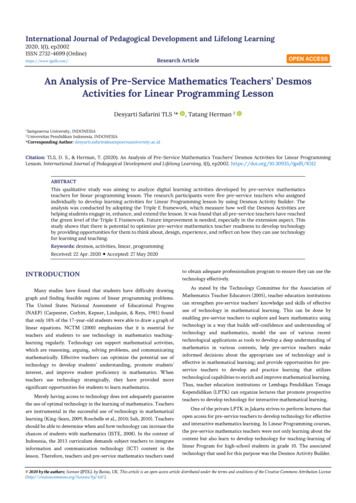
Transcription
International Journal of Pedagogical Development and Lifelong Learning2020, 1(1), ep2002ISSN 2732-4699 (Online)https://www.ijpdll.com/Research ArticleOPEN ACCESSAn Analysis of Pre-Service Mathematics Teachers’ DesmosActivities for Linear Programming LessonDesyarti Safarini TLS 1*, Tatang Herman 2Sampoerna University, INDONESIAUniversitas Pendidikan Indonesia, INDONESIA*Corresponding Author: ion: TLS, D. S., & Herman, T. (2020). An Analysis of Pre-Service Mathematics Teachers’ Desmos Activities for Linear ProgrammingLesson. International Journal of Pedagogical Development and Lifelong Learning, 1(1), ep2002. https://doi.org/10.30935/ijpdll/8312ABSTRACTThis qualitative study was aiming to analyze digital learning activities developed by pre-service mathematicsteachers for linear programming lesson. The research participants were five pre-service teachers who assignedindividually to develop learning activities for Linear Programming lesson by using Desmos Activity Builder. Theanalysis was conducted by adopting the Triple E framework, which measure how well the Desmos Activities arehelping students engage in, enhance, and extend the lesson. It was found that all pre-service teachers have reachedthe green level of the Triple E Framework. Future improvement is needed, especially in the extension aspect. Thisstudy shows that there is potential to optimize pre-service mathematics teacher readiness to develop technologyby providing opportunities for them to think about, design, experience, and reflect on how they can use technologyfor learning and teaching.Keywords: desmos, activities, linear, programmingReceived: 22 Apr. 2020 Accepted: 27 May 2020INTRODUCTIONto obtain adequate professionalism program to ensure they can use thetechnology effectively.Many studies have found that students have difficulty drawinggraph and finding feasible regions of linear programming problems.The United States National Assessment of Educational Progress(NAEP) (Carpenter, Corbitt, Kepner, Lindquist, & Reys, 1981) foundthat only 18% of the 17-year-old students were able to draw a graph oflinear equations. NCTM (2000) emphasizes that it is essential forteachers and students to use technology in mathematics teachinglearning regularly. Technology can support mathematical activities,which are reasoning, arguing, solving problems, and communicatingmathematically. Effective teachers can optimize the potential use oftechnology to develop students’ understanding, promote students’interest, and improve student proficiency in mathematics. Whenteachers use technology strategically, they have provided moresignificant opportunities for students to learn mathematics.As stated by the Technology Committee for the Association ofMathematics Teacher Educators (2005), teacher education institutionscan strengthen pre-service teachers’ knowledge and skills of effectiveuse of technology in mathematical learning. This can be done byenabling pre-service teachers to explore and learn mathematics usingtechnology in a way that builds self-confidence and understanding oftechnology and mathematics, model the use of various recenttechnological applications as tools to develop a deep understanding ofmathematics in various contexts, help pre-service teachers makeinformed decisions about the appropriate use of technology and iseffective in mathematical learning; and provide opportunities for preservice teachers to develop and practice learning that utilizestechnological capabilities to enrich and improve mathematical learning.Thus, teacher education institutions or Lembaga Pendidikan TenagaKependidikan (LPTK) can organize lectures that promote prospectiveteachers to develop technology for interactive mathematical learning.Merely having access to technology does not adequately guaranteethe use of optimal technology in the learning of mathematics. Teachersare instrumental in the successful use of technology in mathematicallearning (King-Sears, 2009; Roschelle et al., 2010; Suh, 2010). Teachersshould be able to determine when and how technology can increase thechances of students with mathematics (ISTE, 2008). In the context ofIndonesia, the 2013 curriculum demands subject teachers to integrateinformation and communication technology (ICT) content in thelesson. Therefore, teachers and pre-service mathematics teachers needOne of the private LPTK in Jakarta strives to perform lectures thatopen access for pre-service teachers to develop technology for effectiveand interactive mathematics learning. In Linear Programming courses,the pre-service mathematics teachers were not only learning about thecontent but also learn to develop technology for teaching-learning oflinear Program for high-school students in grade 10. The associatedtechnology that used for this purpose was the Desmos Activity Builder. 2020 by the authors; licensee IJPDLL by Bastas, UK. This article is an open access article distributed under the terms and conditions of the Creative Commons Attribution /).
2 / 10TLS & Herman / International Journal of Pedagogical Development and Lifelong Learning, 1(1), ep2002Figure 1. Desmos Activity Builder homepage at https://teacher.desmos.com/Lecturers have been familiarizing the pre-service teachers using allfeatures of the Desmos Activity Builder.DESMOS ACTIVITY BUILDERDesmos Activity Builder is a website-based technology that is veryuseful to make students participate actively in mathematics learning.Desmos has many advantages over other programs or applications,which are free, easy to use, intuitive, and powerful tools for creatinggraphics (Ebert, 2014). Desmos Activity Builder is also proven toprovide opportunities for students to learn mathematical conceptsproductively and profoundly. Also, teachers can know the progress oflearning every student in real-time (Jon ORR, 2017). According toGulati (2017), the excellence of Desmos Activity Builder is that studentscan experience multiple learning opportunities. Students can use thegraphs feature to create plots, convey their ideas, share their findingswith other students and review their learning progress. Teachers canalso see the progress of learning every student during the class.Teachers can use the pause feature to ensure that each student is focusedon class discussions and respond to each other’s findings. Teachers canalso identify students who need individual support. Students also havethe opportunity to learn according to their abilities and pace. Teachersare expected to tailor special activities to their students and also meeteach student’s learning needs.Desmos is known as a website that provides free online graphingcalculator. Desmos has the vision to support each student in studyingmathematics and liking it. To achieve that vision, Desmos developed anew program called Desmos Activity Builder, which facilitatingteachers to easily develop interactive and meaningful digitalmathematical learning activities. Desmos learning activities canencourage students to actively create mathematical ideas rather thangetting knowledge from the teacher. Students are also stimulated toshare ideas, create, and ultimately build understanding and generatenew knowledge.Based on the above explanation, Desmos Activity Builder is a free(open source) website-based application which capable of facilitatinginteractive mathematical learning activities, informing students’learning progress in real-time mode, and free access for students withmathematics. Taking into consideration the excellence of DesmosActivity Builder on mathematical teaching-learning, this research isaiming to conduct studies on the analysis of pre-service teachers’Desmos activities for linear programming lesson. The results of thisstudy are valuable for further study of the technological pedagogicalcontent knowledge (TPACK) competency of mathematics pre-serviceteachers. Additionally, this study provides a recommendation to theassociated LPTK on how to improve the competence of prospectiveteachers in using and developing technology for mathematics lesson.The research question for the study was: how well the Desmos ActivityBuilder developed by mathematics pre-service teachers meet thelearning goals in Linear Programming lesson according to the Triple EFramework?Not only students gain benefits from Desmos Activity Builder, butthe teacher also gained experiences in creating a series of mathematicaldigital learning activities that emphasize the exploratory, analytical andcollaborative aspects. Furthermore, the teacher can monitor andevaluate each student’s learning progress in real-time mode through thedashboard feature of Desmos Activity Builder. Teachers can easily findout if there are students who have difficulties or have misconceptionsso that the teacher can immediately provide the support needed by thestudent. To avoid misconceptions and to scaffold students through thegiven activities. Teachers can create digital learning activities er.desmos.com/page and then create for a free account.Figure 1 shows the homepage of Desmos Activity Builder.Teachers can adapt and edit digital learning activities developed byDesmos or other users. For example, there exists a sample of digitallearning activity in Desmos Activity Builder that has been developed bya user and can be adopted by teachers or other users for teachinglearning of linear programming. Teachers can use the activities bygenerating a new class code, and then it will be shared with studentsbefore the class start. Teachers can use the same activity for differentclasses by generating different class code. Thus, teachers do not need tocreate new activities. The teacher can customize the activity to meet thestudents’ needs. Figure 2 shows a view of the Desmos Activity Builderfor the linear programming topic.Desmos provides many video tutorials for teachers to learn moreabout how to create interactive digital learning activities using Desmos
TLS & Herman / International Journal of Pedagogical Development and Lifelong Learning, 1(1), ep20023 / 10Figure 2. Sample of Desmos Activity Builder for Linear ProgrammingTable 1. The Triple E RubricEngagement in the learningThe technology allows students to focus on the assignment/activity/goals with less distraction (Time on Task).The technology motivates students to start the learning process.The technology causes a shift in the behavior of the students, where they move from passive to active sociallearners (through co-use or co-engagement).Enhancement of the learning goalsThe technology tool allows students to develop or demonstrate a more sophisticated understanding of thelearning goals or content (using higher-order thinking skills).The technology creates supports (scaffolds) to make it easier to understand concepts or ideas (e.g. differentiate,personalize or scaffold learning)The technology creates paths for students to demonstrate their understanding of the learning goals in a way thatthey could not do with traditional tools.Extending the learning goalsThe technology creates opportunities for students to learn outside of their typical school day. (24/7 connection)The technology creates a bridge between students school learning and their everyday life experiences (connectslearning goals with real life experiences).The technology allows dtudents to build authentic life soft skills, which they can use in their everyday lives.READING THE RESULTS 13-18 Point: Exceptional connection between learning goals and tool 7-12 Points: Some connection between learning goals and tool 6 Points or below: Low connection between learning goals and arn.desmos.com/page to find out more about DesmosActivity Builder. Desmos also facilitated many teachers ‘ professionaldevelopment programs in the form of free online webinars and trainingfor teachers on how to develop and use Desmos Activity Builder formathematic teaching-learning.THE TRIPLE E FRAMEWORKTriple E is a framework for teachers to evaluate the degree to whichthe use of technology supports students to achieve learning goals.Unlike the other technological frameworks, the Triple E Framework’sfocus is on learning goals and not specific technological tools. Thisframework stems from an educational study of effective and ineffectivepractices utilizing technologies over the past two decades. The Triple Emeasurement rubric was created primarily for teachers and K-12administrators to be used in developing lesson plans, evaluating the0 No1 Somewhat2 Yes0 No1 Somewhat2 Yes0 No1 Somewhat2 YesTOTALS/18potential effectiveness of educational applications in learning, andassessing the potential impact of technological tools in lesson plans.This framework consists of three components: Involvement in learningobjectives, Improving learning objectives, and Expansion of learningobjectives. A recent independent mixed method study conducted in2018 found Triple E to be valid and reliable.The following rubric can be used to measure whether technologyhas a positive impact on student learning goals. The results are toanalyze lessons or learning activities that integrate technology in theclassroom. The results give teachers information about how welltechnology supports students to achieve learning goals (see Table 1).In order to determine if the technology is having a positive impacton student learning goals, the Triple E framework also provides aqualitative analysis which categorizes into three levels as follows:
4 / 10TLS & Herman / International Journal of Pedagogical Development and Lifelong Learning, 1(1), ep2002Table 2. Desmos Activities Link and Students’ Access CodeInitialTAMWRNAHERDesmos Activities 50https://teacher.desmos.com/activ
learning (King-Sears, 2009; Roschelle et al., 2010; Suh, 2010). Teachers should be able to determine when and how technology can increase the chances of students with mathematics (ISTE, 2008). In the context of Indonesia, the 2013 curriculum demands subject teachers to integrate information and communication technology (ICT) content in the lesson. Therefore, teachers and pre-service .
